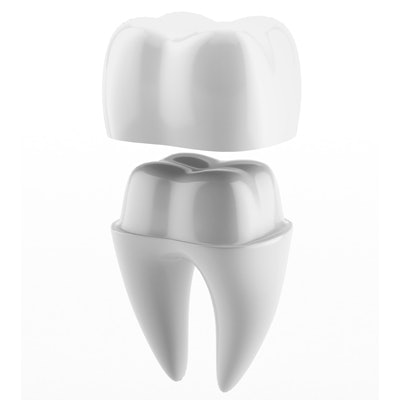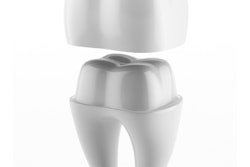
All-ceramic CAD/CAM crowns are a treatment option for full-coverage restorations for endodontically treated teeth, but how do they resist fracturing? Researchers compared two kinds of crowns to see which held up best.
Crowns with an amalgam core foundation generally resisted failure better than so-called endocrowns, they found.
"Crowns supported by amalgam cores demonstrated more favorable modes of failure," the researchers wrote (Journal of Esthetic and Restorative Dentistry, August 25, 2018).
The study was led by Lt. Col. Aaron Krance, a dental flight commander at the Dover Air Force Base in Delaware. This study is part of Krance's work toward a master's degree in oral biology from the Uniformed Services University of the Health Sciences in Bethesda, MD.
Coverage options
Endodontically treated teeth have traditionally been restored with complete crown restorations supported either by direct resin or amalgam core materials assisted with post and cores when needed. All-ceramic, CAD/CAM full-coverage restorations are becoming increasingly popular as these restorations combine relatively fast prosthesis fabrication with acceptable marginal accuracy.
“Crowns supported by amalgam cores demonstrated more favorable modes of failure.”
Advocates of CAD/CAM use emphasize the so-called endocrown method for these teeth, according to the study authors. This method consists of a merged crown-and-core unit adhesively bonded into the pulp chamber and the remaining tooth structure. This method offers a more conservative option to traditional post-and-core restorative strategies.
The researchers wanted to compare the fracture resistance of endodontically treated molars restored with CAD/CAM lithium disilicate crowns to that of those restored with an amalgam core preparation design.
For their in vitro study, they divided 84 extracted mandibular third molars into seven groups (12 in each). They embedded molars in autopolymerizing resin, then removed the coronal tooth structure, exposed the pulp chamber, and removed any pulpal remnants.
One group received lithium disilicate endocrowns (Ivoclar Vivadent). Three groups received an amalgam core buildup restoration carved to contour using a high-copper, dispersed-phase amalgam (Permite, SDI) with the pulp chamber (≥ 4 mm) as the sole retentive feature. Three additional groups were restored with amalgam but also with an additional bonded amalgam retentive strategy (Amalgam Bond Plus, Parkell). The researchers further divided the amalgam core groups into those with 0-, 1-, and 2-mm dentin axial wall heights. Then after 24 hours, they loaded the specimens to failure on a universal testing machine.
The amalgam core group with the 1-mm axial wall height had the highest failure load, the researchers reported. The endocrowns had a lower failure load than the 1- and 2-mm amalgam groups (see table below). Higher failure load indicates better results.
| Mean failure load comparison between endocrown & amalgam core crowns | |||||||
| Amalgam core | Bonded amalgam core | ||||||
| Endocrown | 0-mm wall height |
1-mm wall height |
2-mm wall height |
0-mm wall height |
1-mm wall height |
2-mm wall height |
|
| Failure load (No.) | 242.9 | 254.0 | 299.3 | 273.2 | 273.2 | 281.1 | 217.9 |
| Main failure reason | Catastrophic fracture in tooth and restoration complex | Amalgam core fracture without tooth fracture | Amalgam core fracture without tooth fracture | Cohesive root fracture | Amalgam core fracture without tooth fracture | Catastrophic fracture in tooth and restoration complex | Cohesive root fracture |
Adhesively luted lithium disilicate crowns with amalgam showed more favorable failure modes than endocrown restorations, the researchers found.
Viable treatment option
The authors listed three limitations to their study:
- Only one self-adhesive luting agent was used.
- A specimen thermocycling challenge was beyond the scope of this evaluation due to equipment limitations.
- Cyclic fatigue forces were not measured.
Nevertheless, the study results suggest that lithium disilicate complete crowns may be a viable treatment option when suitable tooth structure and sufficient interact restorative space exist, they concluded.
"Lithium disilicate complete crowns based on preparations with amalgam core foundations containing 1 mm and 2 mm of dentin axial wall height could serve as a suitable restorative option that may provide more recoverable failure modes than endocrown restorations," the authors wrote.



















